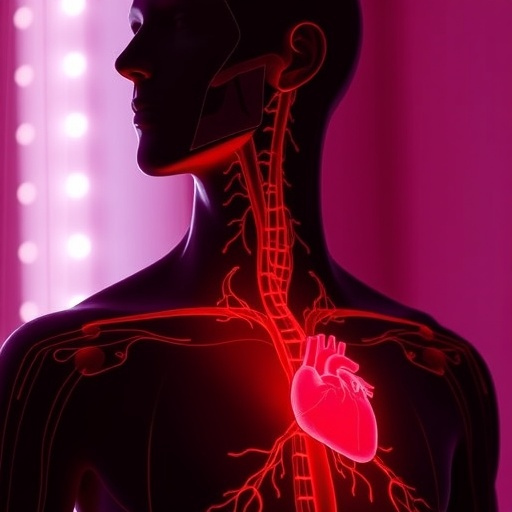In a groundbreaking exploration of innovative therapies for cardiovascular disease recovery, the study by Barone-Rochette et al. shines a spotlight on the potential of red and near infrared light treatment. This promising avenue of research, published in the prestigious journal “Annals of Biomedical Engineering,” aims to investigate whether these light therapies can significantly enhance the healing process for those afflicted by cardiovascular ailments. The implications of their findings could reshape treatment protocols and improve recovery outcomes for millions worldwide.
Historically, light therapy has been utilized for a variety of medical conditions, from skin ailments to mood disorders. However, its application in the realm of cardiovascular health is relatively new and under-explored. The researchers have set out to advance our understanding by targeting cellular mechanisms that may be responsible for recovery post-cardiovascular events. This focus not only helps delineate the physiological impacts of light on the body but also opens doors to potential clinical applications in cardiac rehabilitation settings.
The premise of using light as a therapeutic tool lies in its ability to interact with cellular components. Specifically, light wavelengths, particularly in the red and near-infrared range, can penetrate skin and tissue to stimulate mitochondrial activity. Mitochondria, the powerhouse of the cell, play a pivotal role in energy production and cellular repair. Enhancement of mitochondrial function through light exposure could lead to increased ATP (adenosine triphosphate) production, which is essential for cell survival and recovery.
Central to this study is the investigation of how red and near-infrared light exerts its effects at the cellular level. The authors delve into the science of photobiomodulation— a process that involves the absorption of light energy by photoreceptors in cells. This interaction triggers a cascade of biochemical reactions that can promote healing phenomena, such as angiogenesis, inflammation reduction, and apoptosis regulation. Angiogenesis, the formation of new blood vessels, is particularly crucial for cardiovascular recovery, as it enhances blood flow and nutrient delivery to damaged tissues.
Furthermore, the paper draws attention to the methodological aspects of their analysis, which involved both in vitro and in vivo experiments. The researchers meticulously designed their experiments to extract reliable data that would support their hypotheses regarding the effectiveness of light therapy. In vitro studies included cultured cardiovascular cells exposed to varying wavelengths of light, while in vivo components assessed physiological responses in animal models subjected to simulated cardiovascular events.
Moreover, the timing of light exposure and its duration are emphasized as critical factors influencing therapeutic outcomes. The authors note that certain intervals for light application may optimize its benefits, aligning with natural healing processes. The synchronization of therapy with the biological rhythms of the body intrigues scientists, suggesting that personalized treatment schedules could further enhance recovery trajectories for cardiovascular patients.
The results from these investigations spark excitement within the scientific community. Preliminary findings indicate that light therapy may foster significant improvements in healing rates, ranging from enhanced tissue regeneration to improved cardiac function. These advancements underscore the potential for integrating light-based interventions within existing rehabilitation frameworks, creating a holistic approach to patient recovery.
Ethical considerations surrounding new treatment modalities are paramount. Barone-Rochette et al. address the need for careful evaluation of light therapy’s safety profile. Early-phase findings must be corroborated by larger clinical trials to ensure that any new intervention does not exacerbate existing conditions or introduce unforeseen risks. This vigilance serves to uphold the highest standards of patient care, ensuring that any adopted therapies are both efficacious and safe.
Community health outcomes also loom large in the discussion. Cardiovascular disease remains a leading cause of morbidity globally, with millions affected by complications that hinder day-to-day activities. Should red and near infrared light therapies prove to be effective, the implications could extend far beyond individual patients to encompass broader societal health improvements. By facilitating faster recoveries and reducing the burden on healthcare systems, this innovative treatment could signal a transformative period in cardiovascular care.
Looking ahead, the study’s authors highlight the necessity for interdisciplinary collaboration in advancing the understanding of photobiomodulation within cardiovascular medicine. Engaging experts across fields—ranging from bioengineering to clinical cardiology—will further enrich the discourse and enable more comprehensive insights into how light therapies can be harnessed effectively. Such collaborations can also facilitate the development of practical light therapy devices aimed at both clinical environments and home use.
In conclusion, Barone-Rochette et al. unveil a captivating glimpse into a future where light therapy becomes an integral component of cardiovascular disease recovery strategies. With the foundation laid by their research, the potential for transforming treatment paradigms exists—offering hope for patients seeking novel and effective recovery options. As further studies build upon these insights, the scientific community eagerly anticipates the advances that may emerge from this illuminating approach to health and healing.
The journey of red and near infrared light treatment in the field of cardiovascular recovery is just beginning. As researchers chronicle their findings and refine their techniques, the therapeutic benefits presented by photobiomodulation could rewrite the narrative of cardiovascular rehabilitation. With continued exploration and validation, this innovative therapy may offer a beacon of hope for millions, illuminating the path to a healthier future.
Ultimately, the path forward will require not only innovative scientific inquiry but also the active engagement of healthcare providers, policymakers, and patients alike. A collective effort will forge the way toward integrating these novel therapies into everyday practice, ensuring that all communities gain access to potential breakthroughs in cardiovascular care.
As we stand witness to the evolving landscape of medical science, the synergy of light and health encapsulated in Barone-Rochette et al.’s work embodies a harmonious vision. This research acts as a catalyst, stimulating further exploration into the uncharted territories of healing. With the promise of red and near infrared light treatment, we may soon find ourselves at the forefront of a revolution in recovery for cardiovascular disease.
Subject of Research: Red and Near Infrared Light Treatment for Cardiovascular Disease Recovery
Article Title: Lights-on for Cardiovascular Disease: Can Red and Near Infrared Light Treatment Help the Recovery Process?
Article References:
Barone-Rochette, G., Cochard, L., Billeres, M. et al. Lights-on for Cardiovascular Disease: Can Red and Near Infrared Light Treatment Help the Recovery Process?.
Ann Biomed Eng (2025). https://doi.org/10.1007/s10439-025-03884-y
Image Credits: AI Generated
DOI: 10.1007/s10439-025-03884-y
Keywords: cardiovascular disease, light therapy, photobiomodulation, recovery, mitochondrial activity, angiogenesis, rehabilitation.
Tags: advances in biomedical engineering researchcellular mechanisms in heart recoveryenhancing healing process for cardiovascular ailmentsexploring light therapy for medical conditionsimplications of red light therapy researchinnovative therapies for cardiovascular diseaselight therapy in cardiac rehabilitationmitochondrial activity stimulation with lightnear infrared light treatment for cardiovascular healthred light therapy for heart recoverytherapeutic applications of light in healthcaretreatment protocols for heart recovery





